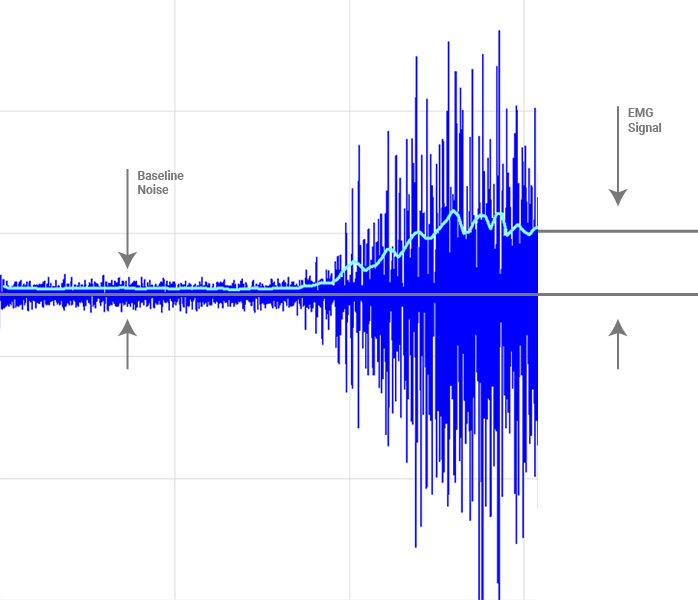How to improve EMG signal quality
The patent-pending Signal Quality Monitor provides feedback of the quality of the recorded EMG signals by automatically assessing the following EMG signal parameters in real-time during data acquisition:
The SNR is the best measure of the quality of the EMG signal. It indicates the ratio of the EMG signal during muscle contraction versus the unwanted electrical signal recorded when the muscle is at rest, i.e. the baseline noise.

The higher the SNR, the more reliable the discrimination of EMG data from the underlying baseline noise.
To improve the SNR:
- Reduce the baseline noise by following the steps outlined in the next paragraph.
- Increase the EMG signal amplitude by re-positioning the sensor on the muscle of interest. Delsys sensors can be used as probes prior to final placement, and their position can be shifted on the contracting muscle to identify the location and orientation of the sensor that maximizes the amplitude of the EMG signal and minimizes interference from neighbouring muscles.
The baseline noise reflects the stability of the skin-electrode interface and can be assessed by recording the electrical signal from the relaxed muscle.

Although baseline noise cannot be completely eliminated, it can be reduced by effective preparation of the skin.
For routine applications:
- Shave excessive hair, if necessary, to ensure a secure skin-electrode contact.
- Wipe the skin with an alcohol swab to remove oil and debris at the site chosen for sensor application.
For more extreme conditions, such as in persons with dry skin, additional preparatory steps should be executed:
- Remove the surface layer of dead skin by light abrasion of the skin, i.e. repeatedly apply and peel off hypoallergenic tape.
- If the skin is too dry, moisten the skin with a mild solution of soap and water and wipe dry.
Noise from power lines (50 or 60 Hz) and electrical devices originate from the electromagnetic radiation that is pervasive in all environments, and may in some cases contaminate the EMG recording.

If this occurs:
- Use a fresh alcohol prep pad to re-moisten the sensor application site so that it is moist and re-apply the sensor.
- Ensure that there is no instrumentation in the vicinity of the recording area or electrical connection introducing line interference in the recording.
- Make sure that the power lines in the room have a ground reference. This is not always the case in older structures.
As a last resort, locate the EMG system and the subject in a more electrically quiet room.
Sensor detachment or excessive EMG signal amplitude may cause saturation, commonly referred to as “clipping”.

If this occurs:
- The contact between the sensor and the skin should be secured.
- The amplifier gain should be reduced if possible.
- The location of the sensor on the muscle should be moved to reduce the EMG signal amplitude.
Acceptable Values and Recommendations
Feedback for EMG signal to noise ratio (SNR), level of baseline noise, and presence of clipping and line interference is displayed in the form of analog meters. The acceptable range for EMG signal quality is indicated in green, unacceptable values are indicated in red.
If the meter indicator for one or more parameters lies outside the acceptable range, follow the recommendations above to improve signal quality before continuing data acquisition. Poor sensor attachment or skin preparation should be checked first, as they are the most likely cause.

SNR
(range 0-40)
SNR > 1.2
Acceptable SNR
15 µVrms < Baseline Noise < 20 µVrms
Baseline noise not ideal
SNR ≤ 1.2
Insufficient signal or excessive baseline
Recommendation
Check for baseline noise. If baseline noise is excessive, follow the recommendation to reduce it. If acceptable, re-position the sensor to increase the EMG signal amplitude.

Baseline Noise
(range 0-40)
Baseline Noise < 15 µVrms
Acceptable baseline noise
15 µVrms < Baseline Noise < 20 µVrms
Baseline noise not ideal
Baseline Noise > 20 µV
Excessive baseline noise due to a poor skin interface
Recommendation
Use a fresh alcohol prep pad to re-moisten the sensor application site so that it is moist and re-apply the sensor. If the interface is still marginal, repeat the basic skin preparation steps, including cleaning with alcohol pad, tape peel the skin, remove excessive hair if needed.

Line or Clipping Interference
(range 0-10)
Line Interference < 2
Minimal line interference
No Clipping
clipping not present
15 µVrms < Baseline Noise < 20 µVrms
Baseline noise not ideal
Line Interference > 2
Excessive line interference
Clipping
Clipping is present
Recommendation
Use a fresh alcohol prep pad to re-moisten the sensor application site so that it is moist and re-apply the sensor. If line interference is still excessive, check for sources of interference in the recording area.
If the signal is clipped, secure the contact between the sensor and the skin, reduce the amplifier gain or re-position the sensor to reduce signal level.
